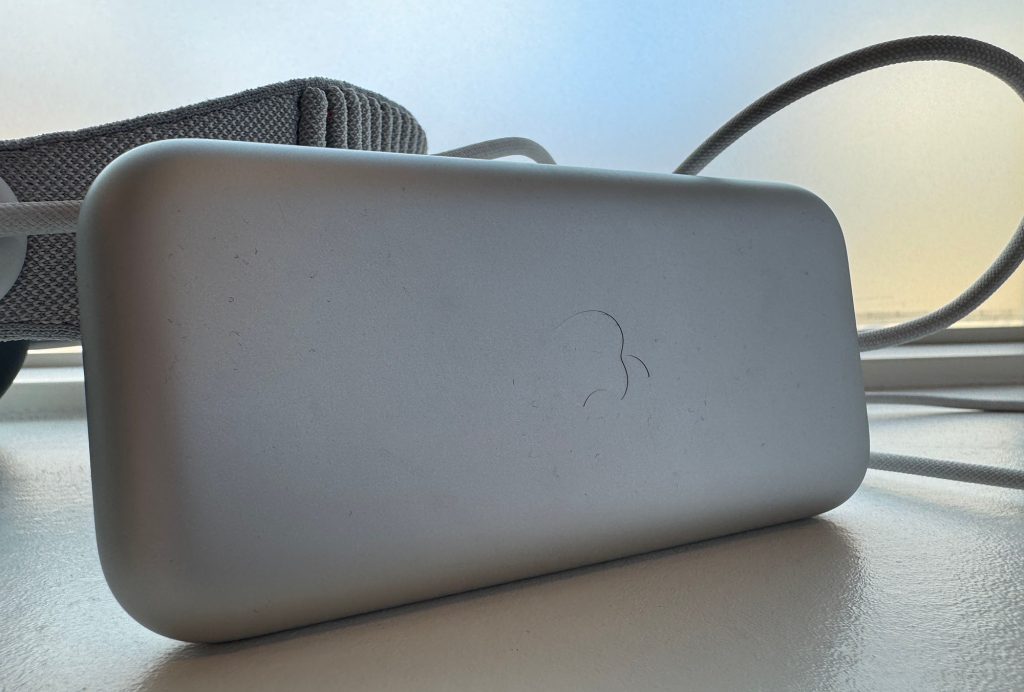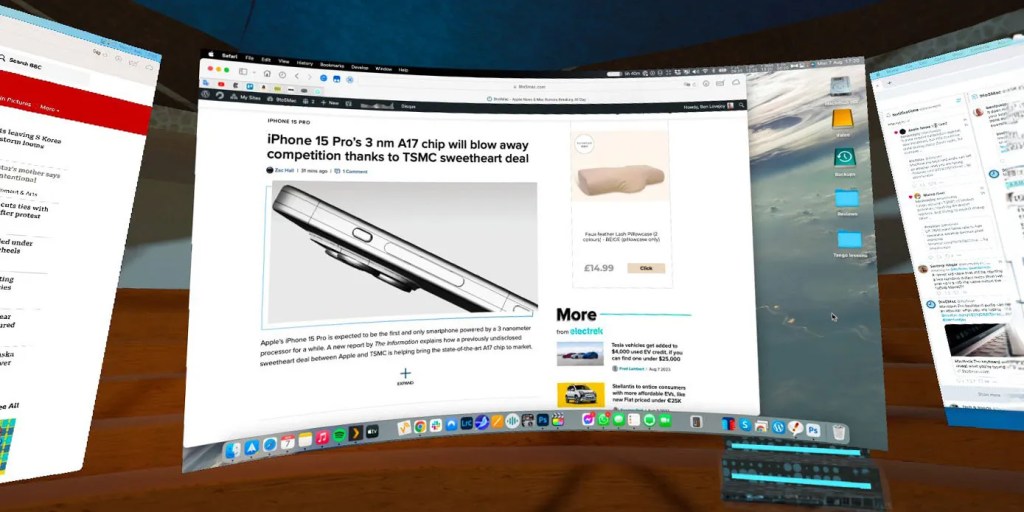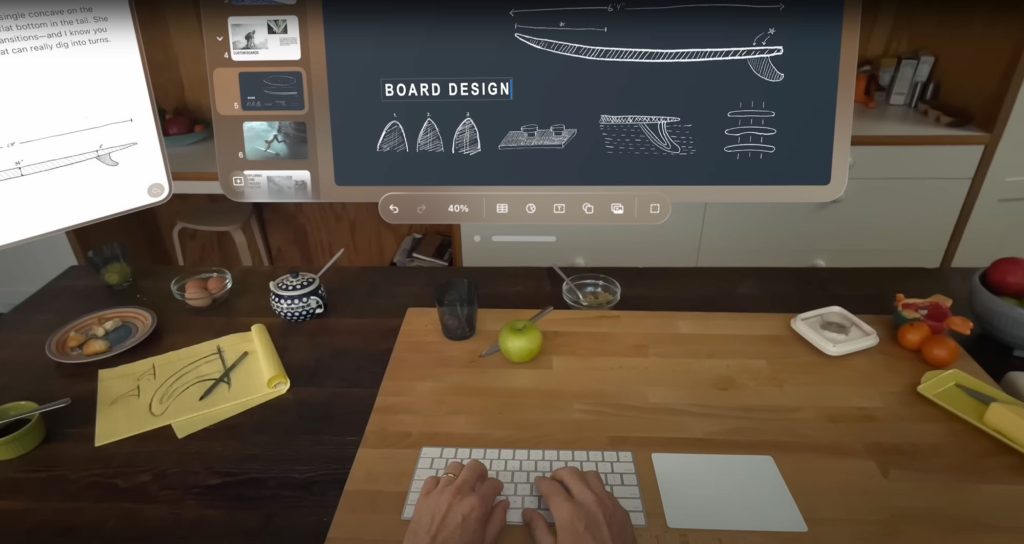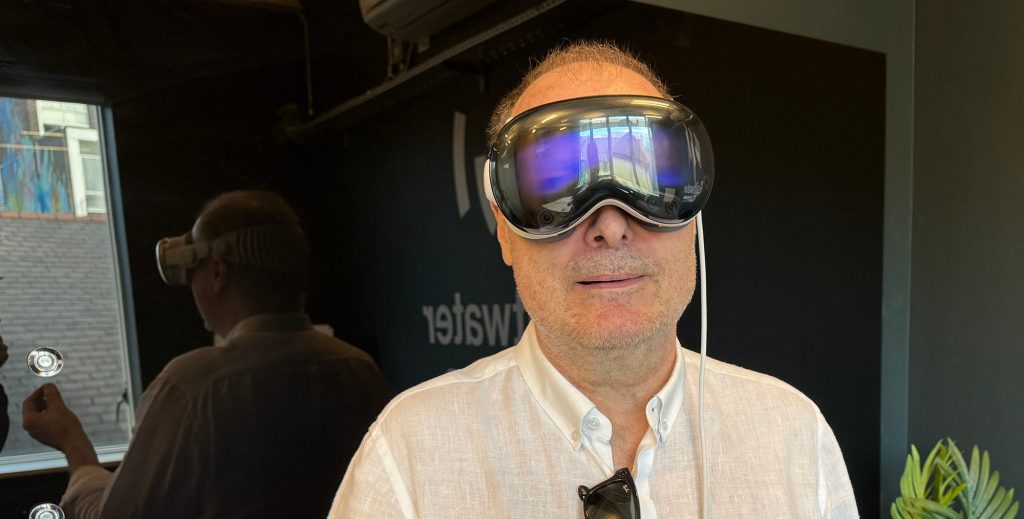
I’ve tried a lower-end headset and I’ve tried a higher-end headset, but the US-only launch of the Vision Pro meant I had to look forward to my chance to use Apple’s space computer here in the UK .
I wouldn’t have much longer to wait, with demos available on June 28, but UK-based developer Maze Theory offered me a chance to try one out a little early…
Despite never having seen the Vision Pro in the flesh before, constant exposure to photos and videos meant it felt quite familiar.
Indeed, the only thing that still looked foreign, perhaps because Apple has carefully avoided including it in its photos, was that external battery pack.

I got an unexpected experience of Apple’s accessibility features when the device successfully calibrated to my eyes, but then refused to let me point to anything while looking at it. A childhood eye injury means I have a very enlarged right pupil, and I suspect that’s what’s confusing it.
However, Maze’s head of games Russ Harding dug into the settings and found an option to control Vision Pro with one eye. We opted for my left eye and things worked out fine after that.
User interface and AR environment
Again, because I had seen so many photos and videos, the overall look of the main VP screens was familiar.
The graphics look amazing! Although somewhat sensitive to the position of the headphones – I occasionally had to make small adjustments when things in the corner went out of focus. However, keep in mind that I was using a shared device, which we had only spent a few minutes setting up for me. A custom fit will likely solve this.
The user interface is very simple – almost also simple! Because most things don’t require you to tap or manipulate any buttons, just look at something and then grab anywhere, I found it wasn’t immediately intuitive. But it only took a very short time to get used to it, and then it’s just amazingly easy to use!
Before I tried it, I wasn’t really sure what to make of the augmented reality approach. On my Quest 2, the background of the virtual monitors is artificial, so you are essentially in a VR environment rather than an AR environment.

With Vision Pro, it defaults to an AR experience, with your app windows floating around your real-world environment – with Optional to reduce the opacity, or replacing it with a VR background.

Ahead of time, I was somewhat skeptical of the benefit of this. After all, my focus will be on the screens, so a real-world review of my surroundings seemed like it might feel pointless or even actively distracting.
However, once I experienced it, I experienced it totally sold! Partly for the practicality of things like being able to see a keyboard and keyboard, and partly just for the massively reduced feeling of being disconnected from the world around you.
It’s also great to be able to see when someone walks into the room so no one around you feels like they’re being ignored.
EyeSight is just a pointless gimmick
However, the other way around – people being able to see me, but not really, like EyeSight – struck me as a pointless gimmick. When Russ was wearing the device and I was seeing his eyes, it didn’t feel like I was actually seeing his face, and when I saw a picture of my eyes on it, it was the same – just a waste of technology.

Apple has reportedly scrapped plans for a Vision Pro 2 and is instead focusing all of its efforts on a lower-cost Apple Vision product. The company is said to be trying to find ways to bring the cost down to a more consumer-friendly level, with many suggesting that it needs to cut the cost by more than half to reach a $1,500 price point. The EyeSight drop is a complete problem here.
As Apple announced this as a key feature, intended to alleviate the sense of isolation between a VP user and those around them, I’m sure they won’t hesitate to remove it.
I have to say watching someone using VP is kind of comical, especially typing on a virtual keyboard! The same was true when I saw myself on that reflective wall. But hey, I’ve used a lot of technology in public that is likely to cause a stir among non-tekhirats.
comfort
Overall, I got to wear the device for about an hour, and based on that experience, I’d say comfort is one of the biggest challenges with this technology right now.
It was a relatively warm afternoon by UK standards and I was definitely feeling the heat with my upper face enclosed by the unit. This mirrors my experience with Meta Quest 2, which also feels warm.
The weight of the Vision Pro is also something I felt after the first 30 minutes or so. I run my Quest with the optional rear battery, and although this adds to the total weight, that mass is split evenly between the front and rear. The Vision Pro, by contrast, is very heavy, and I was definitely starting to feel that, especially when looking down and then up.
I think all AR/VR headset manufacturers should work hard to reduce weight, and I’d say Apple should also address the weight balance of the device.
Graphics
I mentioned that the graphics are great, but the real test was trying Maze Theory’s upcoming game, Infinite Within.
The Vision Pro version isn’t finished yet and I’m not allowed to say much about it, which is probably for the best, since I’m not a gamer! I had warned the company ahead of time that I was only coming to try Vision Pro and test the game’s graphical quality so that everything would work.
Here’s the trailer (note that the virtual hands seen here are from the Quest version, not the Vision Pro):
One cool thing about the game is how you switch back and forth between AR and VR environments. For example, a giant plinth appears in AR form in your room and you have to manipulate objects in this environment in order to unlock VR environments. Switching back and forth between the two environments definitely feels like it adds interest.
The graphics quality is very, very high. Virtual objects do not enough they look as real as the real ones, but it’s so close. After immersing myself in the AR environment, then my brain very quickly began to treat actual and virtual objects as equally real – or perhaps equally unreal!
There was a time when I handed Russ my phone to take the photos seen above, and when he returned it, I kind of did a double take before putting it back on the table. Was that a real table, or was I going to drop my phone on the floor?! Similarly to the plinth, while I could have walked through it, my brain definitely interpreted it as an actual object in the room that I would have to walk around.
There are some issues with object handling in the semi-complete VP version, so the company let me try the game on Quest 3 as well, to see how the handling would be once it’s finished.
A small but dramatic change
Comparing the Vision Pro and Quest 3 versions was really useful as I had the opportunity to do a side-by-side comparison between the two headsets – and the Vision Pro graphics dramatically better.
I very carefully say “felt” rather than looked, because I don’t think it was necessarily about resolution or framerate; rather, it was a small change in equipment capabilities that made a big difference.
In Vision Pro, in-game objects reflect real-life light in the room. So when, for example, I turned an object in my hands, it would reflect the light coming from the real window outside on one side. Quest can’t do that.
This may sound like a relatively small thing, but for me personally, I can’t overstate how much of an impact this had on convincing my brain that virtual objects were real.
Infinite Within it will be available on July 12, in time for the UK launch of Vision Pro.
Will I buy one?
Before the original launch of the Vision Pro, I probably predicted that I wouldn’t buy one, and suggested that I’d probably skip the next version as well – before opting for a third-generation device. After it launched, I said it looked extremely impressive, but my guess was unchanged.
At that point, I suspected that Apple would have to get a future Vision Air model up to about a thousand dollars before it would get my money—and I saw that as many years away.
Has anything changed now that I’ve tried it? Yes and no.
No, I’m still not going to buy the Vision Pro. My main interest is in using it to completely replace a Mac for work on the go, or at least be my multi-monitor setup. Even allowing for a custom fit, the comfort just isn’t there yet to make me wear it for a work day. As an entertainment device, to have a home theater experience anywhere, I am completely satisfied with Viture One XR glasses.
But yeah, I think I’m willing to pay more now than I was before I tried it. If Apple can manage to achieve a device that’s light, balanced and cool enough for all-day use, then I’ll absolutely want one. The idea of being able to travel with just my MacBook and Apple Vision for work is extremely appealing.
Having my external monitors virtual instead of physical and standing in the room without getting in the way when they’re not working is a really good selling point for me. Yes, having multiple Mac monitors in the glasses of the latest Viture model is a big improvement, but the placement of those monitors in the space is just a night and day difference.
So whether If Apple could fix the all-day comfort issue (and I still see that as a pretty big ‘if’), then I think I’d be ready to push the button at $2k rather than $1k.
FTC: We use automatic affiliate links to earn income. More.
